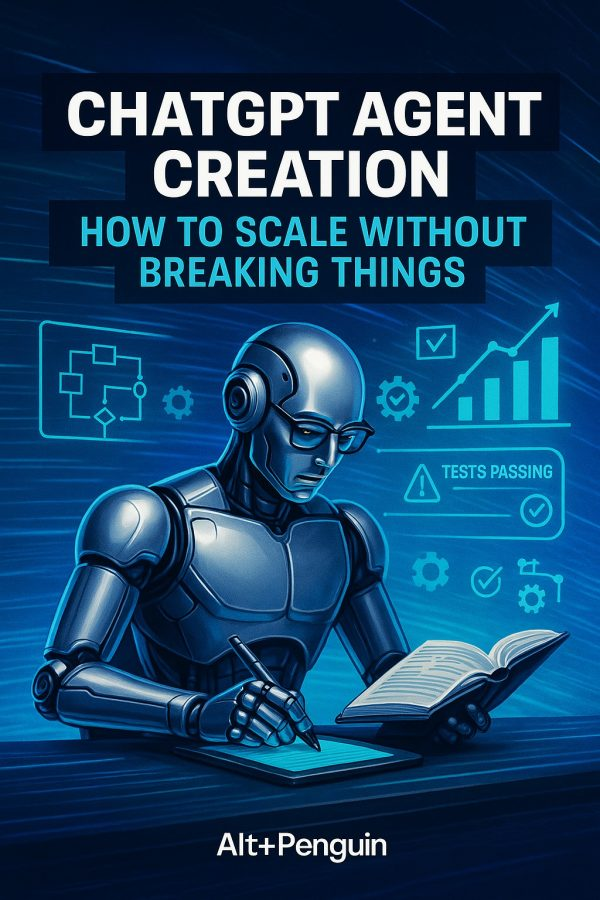Views: 0

Introduction – Scaling With Sanity
In ChatGPT Agent Creation, scaling is a milestone every builder dreams of, alas it’s also where things can start to wobble. You’ve built a working agent, proven it on a smaller scale, and now demand is rising. The temptation? Push everything to maximum power.
But as Yoda might say, “Control, control, you must learn control.”
Scaling isn’t just about more requests per second. It’s about expanding your agent’s reach, capacity, and capability without sacrificing predictability, trust, or cost discipline. In this guide, we’ll break scaling into modular, testable parts, apply governance guardrails, and ensure that both your technical and human systems grow together.
1. What Scaling Really Means in ChatGPT Agent Creation
When we talk about scaling an AI agent, we mean far more than cranking up the compute. True scaling includes:
- Wider task coverage — Handling a broader set of workflows without losing accuracy
- Higher concurrency — Supporting more users in parallel
- Deeper integrations — Expanding to more APIs, tools, and enterprise systems
- Higher stakes — Performing actions where mistakes have real costs
The golden rule: Good scaling preserves predictability. The agent should be faster and broader in scope while staying safe, accurate, and affordable.
Example: A customer service agent that starts with email responses can scale to handle chat, voice transcription, and CRM updates, but only if accuracy, compliance, and cost per ticket stay consistent.
2. Start with Modular Architecture – Scaling Without Entanglement
A monolithic agent is a nightmare to scale. Instead, design your ChatGPT agent as four loosely coupled modules:
- Perception — Input parsing, data extraction, and validation
- Planning — Decision-making, sequencing, and task prioritization
- Tool Use — API calls, database queries, and external system actions
- Memory — Task state, episodic history, and factual knowledge
Benefits of modularity:
- Swap one model for another without rewriting the entire system
- Replace a tool adapter without touching your prompts
- Update prompts without changing your data storage layer
Case Study: Atlassian’s internal AI assistants are built with separate perception and planning layers. This allows them to upgrade their planning LLM without retraining the perception step — saving weeks of engineering effort.
For a primer on modular AI design, see LangChain’s modular agent framework.
3. Scale Selectively – Target the Bottlenecks
Scaling everything at once is expensive and often unnecessary. Instead, diagnose and prioritize bottlenecks:
- Shard memory by product line or business unit to reduce retrieval latency
- Add compute only to the planning step if that’s where delays occur
- Replicate tool adapters behind a load-balancing router if external APIs are bottlenecked
Treat cost as an architectural choice:
- Use largest models where nuanced judgment matters
- Use smaller models for extraction, formatting, and straightforward lookups
Example: A financial compliance agent uses GPT-4 for interpreting policy edge cases. However, it defaults to a smaller model for routine transaction categorization, cutting operating costs by 42%.
4. Build Governance Into the System
A prototype can survive on manual oversight; a scaled agent cannot. As your system grows, bake governance directly into the workflow:
- Automated compliance checks before risky actions (refunds, financial transfers)
- Tiered rate limits by user and tenant to prevent abuse
- Real-time anomaly detection for unusual tool calls or spend spikes
Case Study: Shopify’s AI product listing assistant flags any auto-generated description with potential legal or policy violations before publishing. Ensuring compliance even at massive scale.
For governance frameworks, consult the NIST AI Risk Management Framework.
5. Protect Data with Segregated Memory
When one agent serves multiple clients or departments, memory segregation is non-negotiable.
Best practices:
- Use structured memory types: task state, policy facts, user profile
- Apply namespaces to isolate each client’s data and logs
- Define clear write policies with retention limits
Why this matters:
Segregation prevents cross-contamination, reduces legal risk, and improves retrieval quality by ensuring the agent sees only relevant context.
Example: A multi-tenant legal research assistant improved retrieval accuracy by 28% after isolating client memory pools instead of keeping one shared vector database.
6. Prepare the Human Side – Scaling Adoption
Scaling isn’t just technical, people must trust and use the system.
Adoption accelerators:
- Short, guided onboarding that connects tools and sets permissions
- Simple documentation with real-world examples
- Dry-run mode showing the plan and cost before execution
Trust comes from transparency. When users can see exactly what the agent will do (and what it will cost) before it acts, they’re more likely to adopt it at scale.
7. The Goal – Scaling That Lasts
A system that processes 10,000 tasks per day is impressive. But a system that does so while maintaining user confidence, meeting compliance requirements, and staying within budget is the one that thrives long-term.
The formula for lasting scalability in ChatGPT Agent Creation:
- Build in small, testable modules
- Scale only where bottlenecks exist
- Govern what’s risky
- Protect user data
- Train users for smooth adoption
As Obi-Wan might put it: “Your eyes can deceive you; don’t trust them” in AI terms, don’t trust scale without measurement and guardrails.

